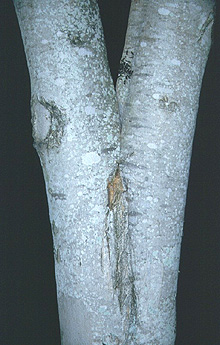From decaying limbs, to weak branch unions, trees can develop a wide range of defects. Co-dominant stems are the one of the most common. The following examines how co-dominant stems form, and their impact on trees.
Understanding Tree Forks
In arboriculture, a tree fork is characterized as a bifurcation in the trunk of a tree that gives rise to two or more branches. Tree forks are a common feature in trees. They are often responsible for producing some of a crown’s most dominant branches. As branches emerge from a tree fork, they establish a connection to the trunk. Branches that form strong connections create a ridge of raised bark at the intersection of the branch and the trunk. This provides each branch with sufficient mechanical support, preventing them from breaking easily. Depending on the health of the tree, and the conditions of its growth, tree forks may also produce co-dominant stems, many of which establish weak connections to the trunk.
What are Co-dominant Stems?
Co-dominant stems form when two or more branches emerge from the same junction, or tree fork. As a tree grows older, the stems develop, remaining similar in size. Many co-dominant stems feature included bark. When this occurs, the stems lack the reinforcing ridge required for the branches to be supported properly. This increases their susceptibility to storms and heavy winds, making them prone to failure. Maples, oaks, and conifers are examples of trees that commonly form co-dominant stems.
What Is Included Bark?
Included bark is a type of branch defect that often develops when two or more stems grow closely together. The bark grows into the union between the stems, causing a weak v-shaped branch angle to form. Included bark lacks strong supportive fiber strength, and prevents branches from establishing strong attachments to the trunk. Co-dominant stems with included bark have an increased risk of failure.
Inspecting and Managing Co-dominant Stems:
When assessing a tree, observe its growth habit, and determine whether it has formed any co-dominant stems. If it has, inspect the quality of the stems’ branch union. If the stems have a v-shaped formation, consider correcting or removing them. Stems with v-shaped formations are more likely to fail than those with u-shaped formations.
The best time to correct co-dominant stems is before a tree has fully matured. For younger trees, completely remove one of the stems. This will enable the remaining stem to assume the terminal role, drastically improving the tree’s structure.
Avoid removing any stems that exceed more than four inches in diameter. This can destroy the tree’s crown, and create a large wound that is unable to seal over effectively. Instead, reduce the weight of the stems by applying selective pruning cuts.
Cabling and bracing can be used to reinforce more extensive stems. To ensure proper installation, the tree must have a balanced crown, and strong, healthy wood. When co-dominant stems become too large, and a cable cannot be established, consider removing the tree altogether.
If the stems are cracked, or exhibit signs of decay, have them promptly removed to avoid injury to landscapes and pedestrians.
Image courtesy of Edward F. Gilman, Professor, Environmental Horticulture Department, IFAS, University of Florida


